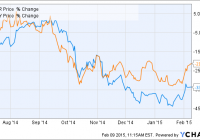Persistent Solar And Oil Correlation Presents Huge Opportunities
Summary Solar continues to be heavily correlated with oil in the stock market despite the fact that these two industries are not in competition with each other. The solar market’s recent downturn, likely influenced by falling oil prices, offers investors a huge chance to profit given that solar fundamentals have been stronger than ever. The solar industry has been recording record growth numbers and improving margins, of which have not been fully reflected in the stock market. No matter how many times it has been stated/proven that solar and oil have almost no real world connection, a large stock market correlation continues to exist between these two industries. The solar sector has followed the price movements of oil rather closely over the past year, which has not be pleasant for solar investors. In fact, the Guggenheim Solar ETF (NYSEARCA: TAN ), which captures the broader solar market, experienced a precipitous drop last year at almost exactly the same time that oil began its decline. The ETF then subsequently experienced an upsurge at around the time when oil prices started recovering. Oil prices have collapsed once again over the past few months, which has pushed solar stocks down once again. While solar and oil are not in direct competition, the market correlation between these two stocks is surprisingly strong. This irrational coupling of solar and oil presents some enormous investment opportunities, as the general solar market is incredibly undervalued at the moment. Despite the fact that solar fundamentals are stronger than ever, with leading solar companies generally reporting record growth numbers and growing margins, the solar sector continues to experience downward pressure. Although solar and oil have very little real world connection, oil prices continue to influence solar company valuations to an extremely high degree. This chart depicts the Guggenheim Solar ETF’s price movements along with those of crude oil. Massive Opportunity The recent drop in leading solar names like SunPower (NASDAQ: SPWR ), SunEdison (NYSE: SUNE ), SolarCity (NASDAQ: SCTY ), and Trina Solar (NYSE: TSL ), represents a large investment opportunity. Given that a sizable percentage of these stock declines are likely due to the solar market’s irrational correlation with oil, there is still significant room for growth. In fact, the stock price movements of these companies have almost nothing to do with their actual fundamentals. Trina Solar and SolarCity, for instance, continue to report record growth numbers and yet have declined by ~one-third since oil price started declining again. Even First Solar (NASDAQ: FSLR ), which blew out expectations in its last earnings report, has experienced a slight decline in this period. It is clear that this solar-oil coupling is not going away anytime soon, which makes for great buying opportunities in the solar sector. The Guggenheim Solar ETF represents a good investment choice for those who are not committed to any single solar company. As this solar and oil correlation will likely eventually disappear as investors becomes more astute, this buying opportunity should be short-lived. Improving Fundamentals The solar PV industry continues to fall precipitously on both the utility-scale and distrbuted fronts. As solar is becoming more economical in a growing number or regions and as world leaders increasingly recognize the long-term potential of solar, global demand is soaring to unprecedented heights. The enormous downward pressures faced by solar stocks this past year would suggests that demand is slowing, and yet the exact opposite has been happening. On top of this, leading solar companies are also experiencing rising gross margins, with number one module manufacturer Trina Solar recently reporting quarterly margins of 20%. Given that all cylinders are firing for both the utility-scale and rooftop solar industries, the solar PV space has never been more exciting. Investors should continue to expect rapid growth in the solar PV arena, especially on the distributed side. While it is easy to place solar and oil in the same market category as they are both forms of energy, it must be remembered that solar has almost nothing to do with oil. Ironically, solar market movements have seen far less correlation with natural gas, which does indeed compete directly with solar. Costs continue to fall on every major solar segment. Source: GTM Research, SEIA Conclusion As long as the irrational solar and oil correlation persists, investors will have large opportunities to profit. With the Guggenheim Solar ETF at a two-year low, the solar sector is set for a turnaround. Despite the fact that the solar industry was still recovering from the industry’s most devastating solar glut two years ago, solar companies during that time had comparable valuations to those of present day solar companies. Investors can clearly profit from the current solar environment given the psychological link between solar and oil. In the inevitable scenario in which solar and oil decouple, solar stocks will likely surge. Disclosure: I am/we are long SCTY. (More…) I wrote this article myself, and it expresses my own opinions. I am not receiving compensation for it (other than from Seeking Alpha). I have no business relationship with any company whose stock is mentioned in this article.

